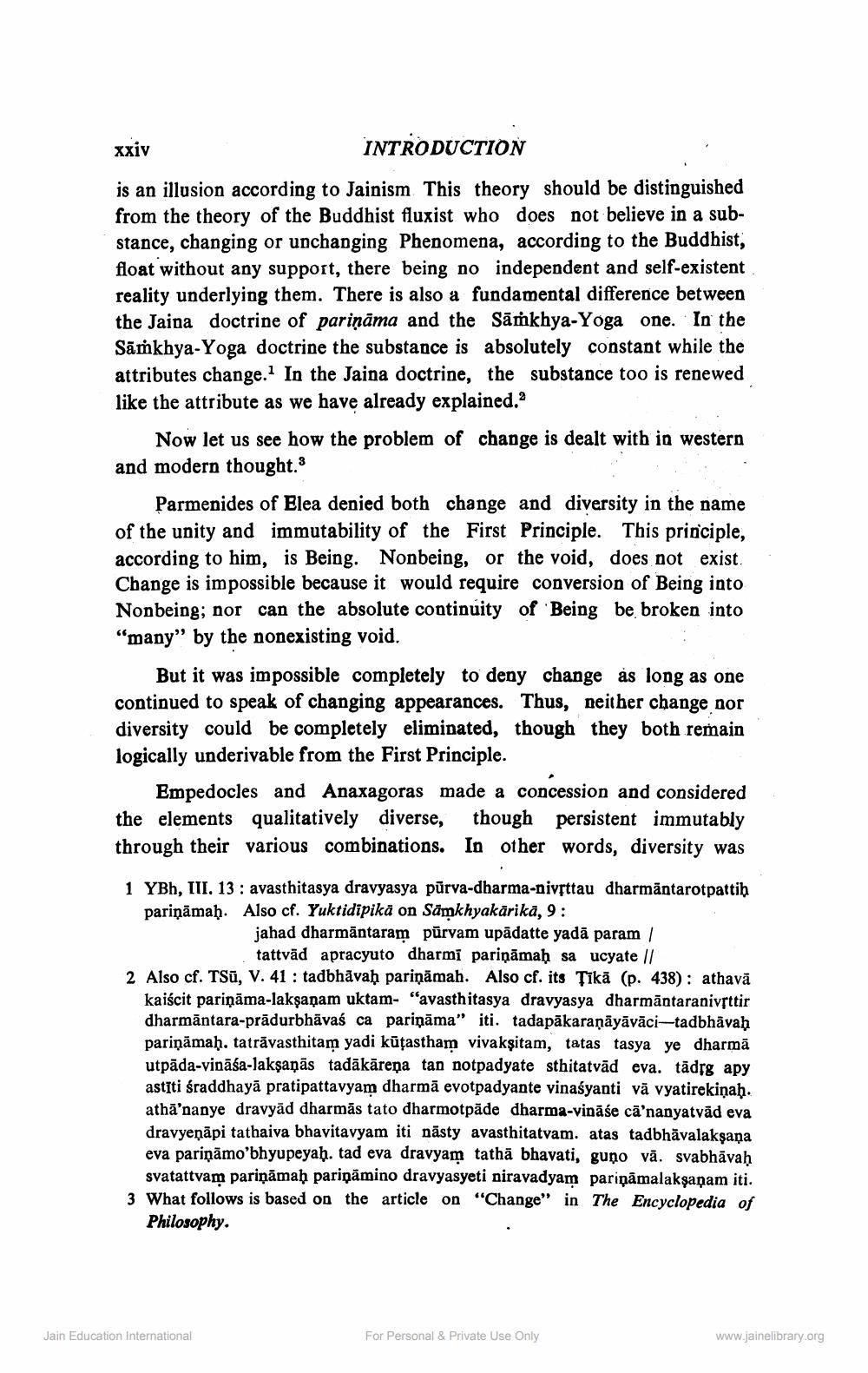________________
xxiv
INTRODUCTION
is an illusion according to Jainism This theory should be distinguished from the theory of the Buddhist fluxist who does not believe in a substance, changing or unchanging Phenomena, according to the Buddhist, float without any support, there being no independent and self-existent reality underlying them. There is also a fundamental difference between the Jaina doctrine of pariņāma and the Samkhya-Yoga one. In the Samkhya-Yoga doctrine the substance is absolutely constant while the attributes change.1 In the Jaina doctrine, the substance too is renewed like the attribute as we have already explained."
Now let us see how the problem of change is dealt with in western and modern thought.3
Parmenides of Elea denied both change and diversity in the name of the unity and immutability of the First Principle. This principle, according to him, is Being. Nonbeing, or the void, does not exist. Change is impossible because it would require conversion of Being into Nonbeing; nor can the absolute continuity of Being be broken into "many" by the nonexisting void.
But it was impossible completely to deny change as long as one continued to speak of changing appearances. Thus, neither change nor diversity could be completely eliminated, though they both remain logically underivable from the First Principle.
Empedocles and Anaxagoras made a concession and considered the elements qualitatively diverse, though persistent immutably through their various combinations. In other words, diversity was
1 YBh, III. 13: avasthitasya dravyasya pūrva-dharma-nivṛttau dharmantarotpattiḥ pariņāmaḥ. Also cf. Yuktidipikä on Sāmkhyakārikā, 9:
jahad dharmantaram pūrvam upadatte yadā param / tattväd apracyuto dharmi pariņāmaḥ sa ucyate //
2 Also cf. TSū, V. 41 : tadbhāvaḥ pariņāmah. Also cf. its Tīkā (p. 438): athava kaiścit pariņāma-lakṣaṇam uktam- "avasthitasya dravyasya dharmantaranivṛttir dharmantara-prādurbhāvaś ca pariņāma" iti. tadapākaraṇāyāvāci-tadbhāvaḥ pariņāmaḥ. tatrāvasthitam yadi kūṭastham vivakṣitam, tatas tasya ye dharma utpada-vināśa-lakṣaṇās tadākāreņa tan notpadyate sthitatvad eva. tādṛg apy astīti śraddhayā pratipattavyam dharma evotpadyante vinaśyanti vā vyatirekiṇaḥ. atha'nanye dravyād dharmās tato dharmotpäde dharma-vinase ca'nanyatvād eva dravyeṇāpi tathaiva bhavitavyam iti nasty avasthitatvam. atas tadbhavalakṣaṇa eva pariņāmo'bhyupeyah. tad eva dravyam tatha bhavati, guno vā. svabhāvaḥ svatattvam pariņāmaḥ pariņāmino dravyasyeti niravadyam pariņāmalakṣaṇam iti. 3 What follows is based on the article on "Change" in The Encyclopedia of Philosophy.
Jain Education International
For Personal & Private Use Only
www.jainelibrary.org




